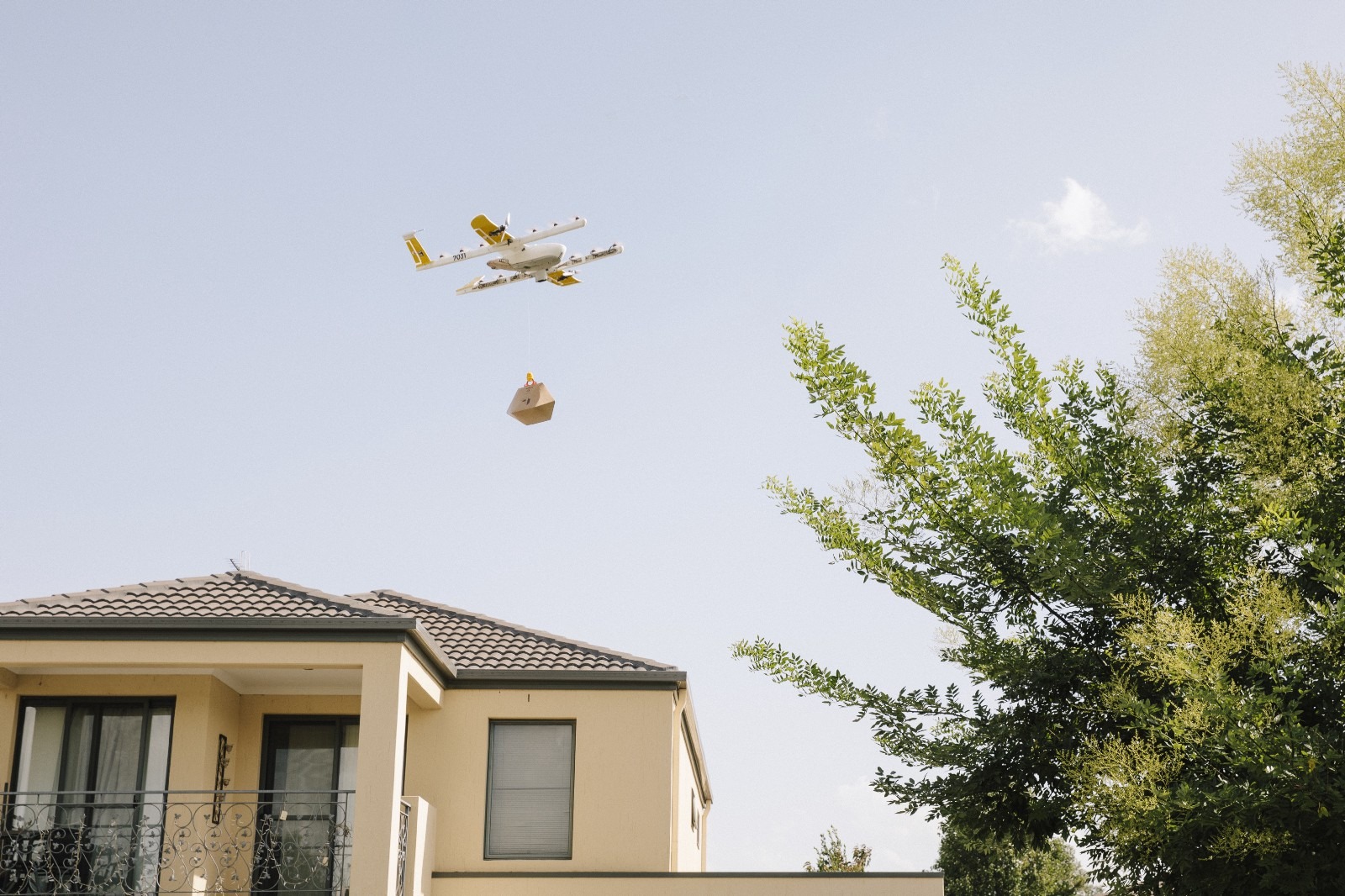Watch your six, Amazon. Google’s Wing Aviation, the first company to receive FAA clearance for drone delivery, is starting trials in Virginia on tech that’s “safer than cars.”
Alphabet’s Wing Aviation is now the first company to receive approval from the US Federal Aviation Administration (FAA) to begin using drones as a commercial operation to deliver goods from local businesses to homes, according to a company statement posted to Medium. As part of the approval, the FAA has created the Unmanned Aircraft System Integration Pilot Program (UAS IPP).
The news is sure to make some consumers leery, but it’s probably a bigger blow for major e-commerce competitor Amazon, which has been developing a 30-minute drone-based delivery service called Prime Air.
“Wing demonstrated that its operations met the FAA’s rigorous safety requirements to qualify for an air carrier certificate. This is based on extensive data and documentation, as well as thousands of safe flights conducted in Australia over the past several years,” wrote the FAA in a press release announcing the approval.
Starting as a Google X project, Wing has spent the last six years working on a small, lightweight aircraft and navigational system that is capable of delivering small packages on demand to specific destinations in only a few minutes.
Wing partnered with the Mid-Atlantic Aviation Partnership and Virginia Tech as one of the participants in the Transportation Department’s Unmanned Aircraft Systems Integration Pilot Program.
Wing has identified a number of benefits that the new opportunity affords, such as delivering medicine or food faster by drone, providing families, shift workers, and other time-starved shoppers with more flexibility. Airdropped packages are also prime for people with disabilities and limited mobility, Wing noted, and have the potential to reduce traffic on roadways and the pollution that comes from fossil fuel-powered vehicles.
“Most importantly, FAA certification required us to submit evidence that our operations are safe. These submissions included data showing that a delivery by Wing carries a lower risk to pedestrians than the same trip made by car. Our drones have flown over 70,000 test flights, and more than 3,000 deliveries to doorsteps, driveways, and backyards of our customers in Australia,” the statement reads.
With approval under its belt, Wing is now focusing on boosting its participation in the UAS IPP in Southwest Virginia. Over the next several months, the company will reach out to businesses and community members in the Blacksburg and Christiansburg areas to discuss its technology, answer questions, and to solicit feedback. If all goes well, Wing will launch a delivery trial later this year.
Wing has been running trials for some time now, which is no surprise considering all the risk sat stake when strapping packages to an unmanned vehicle and propelling it far out of sight. The team completed its first real-world deliveries in 2014 in rural Queensland, Australia, where they successfully transported a first-aid kit, candy bars, dog treats, and water to farmers.
In September 2016, it delivered burritos to students at Virginia Tech in what was, at the time, the largest and longest drone delivery test in the US. Wing has opted for test runs with perishable and temperature-dependent items with the hopes of cracking the challenges that these fragile, time-sensitive items pose.
The Sky’s the Limit but What Else is?
For some, it’s hard to imagine that the day and age of drone deliveries is dawning before our eyes. Despite this stamp of regulatory approval, serious challenges still face the concept primarily when it comes to social license.
“I do expect to see other companies gain approval, and while we have a lot of room in the sky, delivery drones could become an eyesore. Drones also have cameras that capture a huge amount of footage, so it’s going to be important to define how that footage can be used,” Darin Archer, CMO of API-based commerce solutions company Elastic Path, wrote to AgFunderNews. The company provides commerce software solutions that convert any type of customer interaction with a brand into a shoppable opportunity, whether that’s letting customers complete a purchase from a drone delivering a package, through a mobile app, or at an in-store POS or any other touchpoint.
“There will be monetization opportunities for that footage from the many industries that are interested in that sky view, and consumers won’t want their sunbathing viewed by the world. We have a lot of things to work through but unfortunately, I don’t see much existing guidance beyond the Voluntary Best Practices guide, which comes from NTIA, not FAA. I suspect in the next 2-3 years, we’ll see a big, brown drone in the sky along with many others.”
The FAA has taken an understandably cautious approach to the commercial use of drones, gradually rolling back limits and outright prohibitions on their commercial use. In 2016, the FAA released its long-awaited final rule governing the use of small UAS devices. The rules permitted the commercial operation of drones that weigh less than 55 pounds. Most of the restrictions are geared toward limiting safety risks while ensuring user competency. Pilots must keep the unmanned aircraft within their visual line of sight (VLOS), which thwarted many companies’ dreams of using drones for package delivery. Operations during the dawn and twilight hours are limited to drones equipped with anti-collision lights.
With Wing Aviation’s new approval, however, it is unclear whether the VLOS rule will be out the window for drone delivery services. There are plenty of other unknowns, such as whether the government will impose a cap on the size of a fleet of drones that a delivery company can operate nationally or within a jurisdiction, whether the drones must adhere to flight paths within public roadways, and what will happen in the event a drone is intercepted and a package stolen.
Image credit: Wing Aviation making a drop in Canberra, Australia, from Medium.




